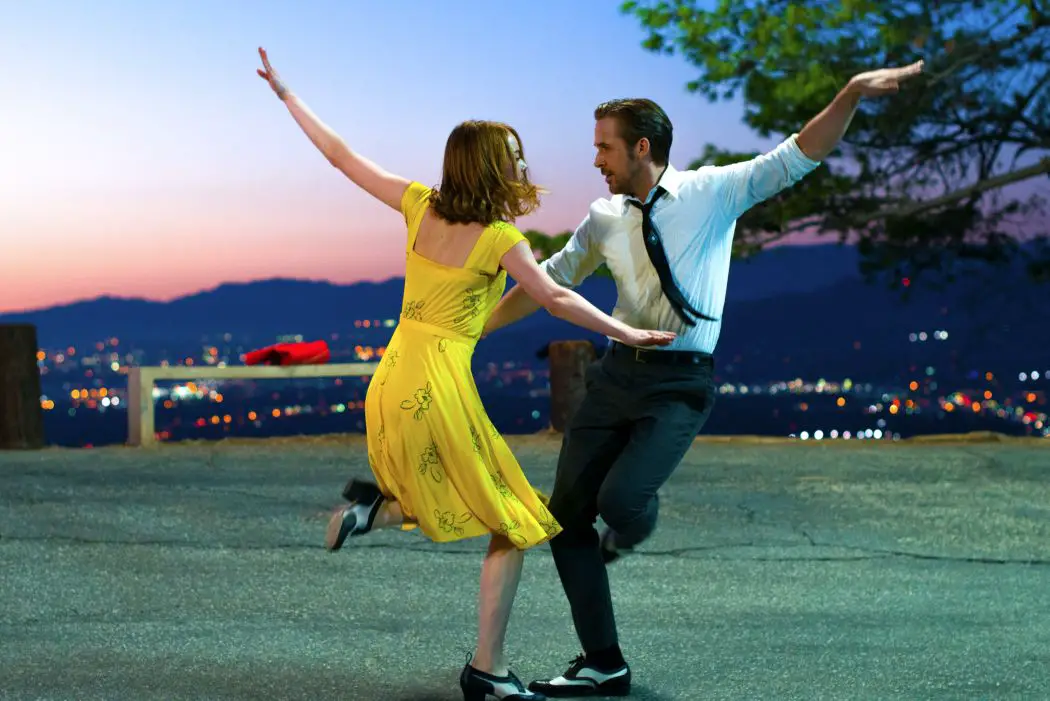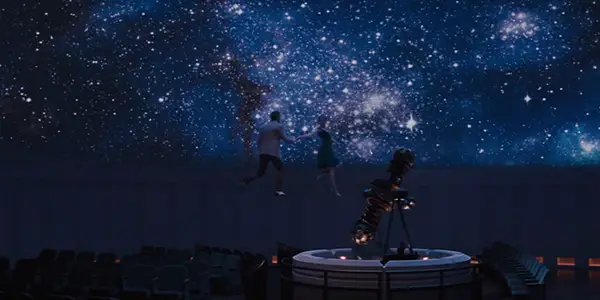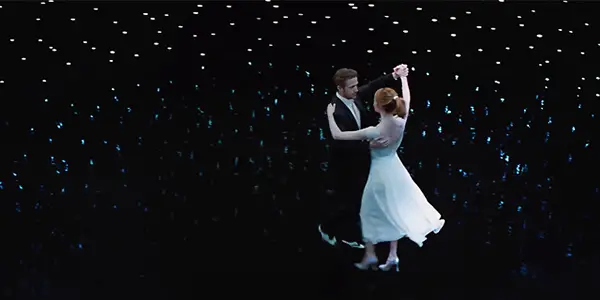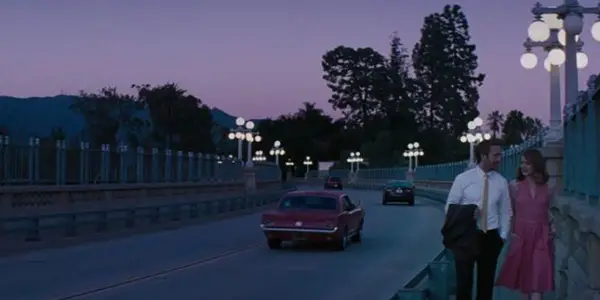LA LA LAND: Succeeds As Both A Tribute & Subversion Of The Classic Musical

David is a film aficionado from Colchester, Connecticut. He enjoys…
Suspension of disbelief is important when approaching any work of fiction. This is especially true within the musical genre, where people express their thoughts and emotions by suddenly breaking into song and dance numbers. Once you accept this simply as the heightened reality of the world, though, there can be much to enjoy about musicals. After all, who could possibly watch Singin’ in the Rain and not have a gaping grin on their face as wide as Gene Kelly‘s?
Damien Chazelle‘s La La Land is very much a tribute to the golden age of musicals, usually thought of as being the 1930s-1960s. There are homages, visual similarities, and even a central premise that is reminiscent of many of them. However, where Chazelle‘s film eventually diverts from this is also what potentially makes it stand out all the more.
La La Land is a film about chasing dreams, which come in the form of our two central characters: Mia Dolan (Emma Stone) is an aspiring actress, while Sebastian Wilder (Ryan Gosling) is a jazz pianist who hopes to one day open his own club. The film focuses individually on each of them, before then following along with their budding romance, and finally the clash that results as they attempt to coincide their relationship with their lifelong ambitions.
Cue the Music
La La Land is a musical, and from the very opening shot, it makes you aware of this. The camera pans down to a Los Angeles traffic jam, and after traversing through the cars and the people within them, is suddenly transformed into a song and dance number, where people exit their vehicles and start to leap around like acrobats on the crowded overpass. It’s an impressive sequence, even more so because of its manner of finding magic in the mundane.

La La Land’s song and dance numbers are very reminiscent of classic musicals, often developing characters specifically by these means as opposed to dialogue. An example is the growing romance between Mia and Sebastian. One sequence, which is shot in an extended, one-shot take overlooking the city of Los Angeles, has a similar budding romantic vibe as Fred Astaire and Cyd Charisse‘s Central Park dance in The Band Wagon.
The film is very much an “I Spy” of references like this; additional homages include allusions to Top Hat, Singin’ in the Rain, and especially the musicals of Jacques Demy, such as The Umbrellas of Cherbourg and The Young Girls of Rochefort. There is one particularly well-shot song and dance number that’s straight out of Demy‘s book of vivid colors and splendor – here, Mia and her flashily-dressed roommates dart around their apartment in preparation for a night out, and later on, at their eventual party, the entire group then breaks out into the same song and dance, while the camera spins in dizzying circles in the center.
The clear highlight of the film, though, would be the scene at the Griffith Observatory, in which Mia and Sebastian, in a scene that is clearly meant to instill a thematic importance due to their own uninhibited ambitions, start to literally float up to the top of the planetarium. With only Justin Hurwitz’s spirited music behind them, the scene is a visual spectacle, with pirouettes and spins framed against the dazzling hues of stars in space.
Non-Broadway Actors
A potential uncertainty I had before seeing La La Land was hearing about the central casting of Gosling and Stone, neither of whom have a background in dance theater. Though the two admirably do their best, and are never unwatchable, I still couldn’t help but think back fondly on the greats – Fred Astaire, Ginger Rogers, Gene Kelly, Cyd Charisse, Debbie Reynolds (RIP).

Gosling, though seemingly a virtuoso at jazz piano, is at times too dry and stiff with his dancing, and while Stone has a great voice (“The Fools Who Dream” is good enough to become a hit on its own), she still doesn’t quite have the flexibility and grace of somebody like Rogers or Charisse. Their lack of experience shows, yet it doesn’t detract too greatly from the film’s overall enjoyment. The casting of non-Broadway actors might even be an intentional allusion to the film’s ultimate takeaway (but more on that later).
Where Gosling and Stone lack in musical talent, they more than make up for in their performances. The two, who Chazelle reportedly chose due to the fact that they “feel like the closest thing that we have right now to an old Hollywood couple”, share a believable onscreen chemistry, which is suitable given its importance in the grand scheme of the film. Stone is especially moving with her portrayal of Mia, giving a performance that ranges from lovable goof to absolutely heartbreaking.
An Anti-Musical
La La Land unexpectedly starts to lose steam about halfway through. Other than one somewhat out-of-place performance containing John Legend as the singer of a modern jazz ensemble, the song and dance numbers become notably less frequent. Though it initially felt jarring to suddenly break form like this, it’s clear that this could also be seen as a symbolically significant decision by Damien Chazelle.
La La Land is a film about dreamers, taking place fittingly in Los Angeles, where many people come to have their dreams fulfilled, yet the great majority leave empty-handed. The theme is one that is familiar in Chazelle‘s work, since Miles Teller‘s character in Whiplash was likewise chasing unrealistic prospects. Whereas that film ended on an adrenaline-filled high, though, La La Land is instead more bittersweet.
Being a lover of musicals myself, it took me some time to come around on this maneuver by Chazelle, yet I ultimately believe that it works by modernizing the genre, showing a story that is much more true to life. This also would, as mentioned earlier, make it more relevant that Emma Stone and Ryan Gosling don’t have a background in theater. These aren’t the godlike creatures that were Fred Astaire or Ginger Rogers – they are normal, everyday Joes who, though talented in their own right, dare to reach for the stars despite the difficulty in achieving their respective ambitions.

The only potential negative here is that Mia and Sebastian’s initial pairing was expressed almost solely through dance numbers. But now, when they start to have difficulties, the film focuses on this through confrontations instead, which makes it more uncomfortable to witness. By removing the airy, carefree atmosphere of a musical, it makes La La Land more grounded, but it also causes it to drag once the musical numbers become less frequent. A more fluid transition between the two halves of the film might have benefited here, as it would have removed the disjointed and sluggish feeling that prevents La La Land from being a completely satisfying success.
Conclusion
To conclude, La La Land is a unique, musically-driven effort by director Damien Chazelle. It is simultaneously a homage and a modernization of musical tropes, and though this works for it by grounding it in real life, it also breaks the tradition of just what makes classic musicals so great.
Perhaps Chazelle‘s film is simply meant to make a statement – we can no longer live in the fairy-tale world of musicals, where everything is wrapped up in a neat little package by the conclusion – as that’s not real life. It’s time to face the consequences of the actions we take, and the reality of the world we live in.
For a film that easily could have just been ripe with clichés, La La Land is instead refreshingly different, and is sure to be a hit with audiences as a result, even if it won’t quite satisfy to the same level the nostalgic lovers of the classic musical.
What did you think of La La Land? Are you a fan of modern musicals?
La La Land opened in the U.S. on December 16 and will release in the UK on 13 January 2017. For all international release dates, click here.
Does content like this matter to you?
Become a Member and support film journalism. Unlock access to all of Film Inquiry`s great articles. Join a community of like-minded readers who are passionate about cinema - get access to our private members Network, give back to independent filmmakers, and more.
David is a film aficionado from Colchester, Connecticut. He enjoys writing, reading, analyzing, and of course, watching movies. His favorite genres are westerns, crime dramas, horror, and sci-fis. He also enjoys binge-watching TV shows on Netflix.













